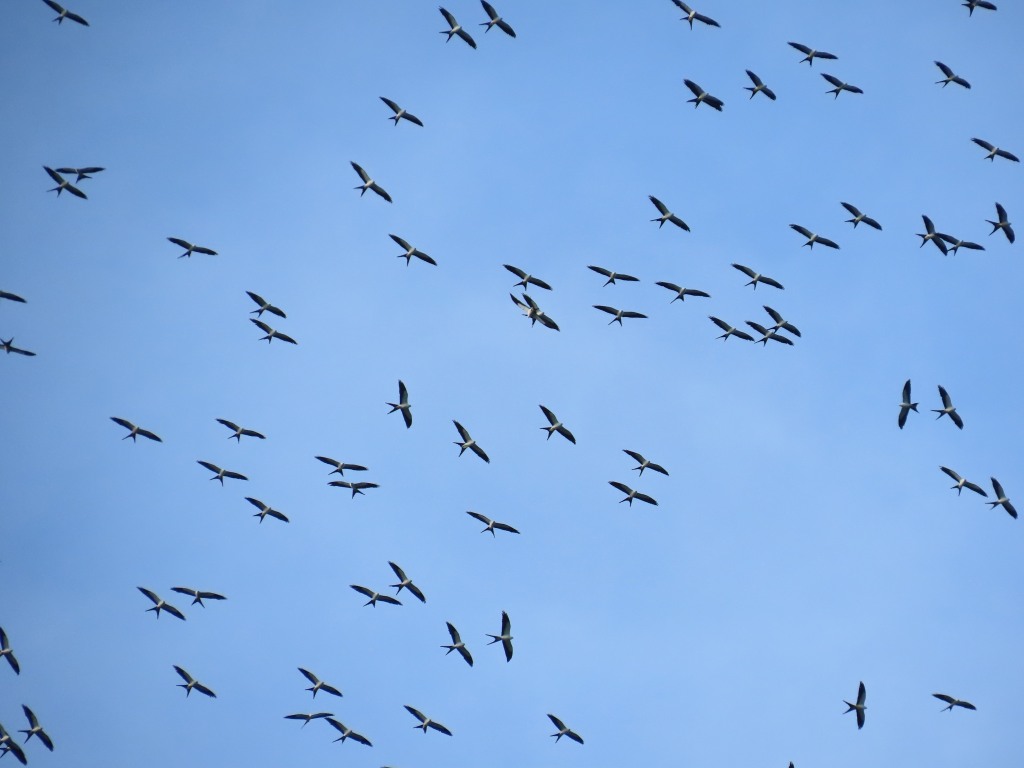
Author: Brian Cammaranao
It’s spring in Florida, the air is warm and the dry season is nearing its end. Occasional tropical showers hint at the coming wet season and migrant birds are on the move. One species in particular, the Swallow-tailed Kite, unmistakable with its contrasting black-and-white plumage and deeply forked tail, catches the eyes of anyone who sees them gracefully flying past. The undeniable elegance of a Swallow-tailed Kite as it effortlessly glides overhead is incomparable to any other bird of prey in Florida. Swallow-tailed Kites return to their breeding grounds, including Highlands County, as early as mid-February. Upon their arrival, they’ve successfully completed their annual migratory journey from their South American wintering grounds. Brian Cammarano, a research intern in the Archbold Avian Ecology Program, excitedly yelled “They’re back, they’re finally back!” to his fellow interns as he pointed out the first pair of the season circling above.
“Every spring, these gregarious raptors migrate in large groups, sometimes numbering in the thousands, as they make their way back North to their breeding grounds,” Brian explained. “Although their breeding range within the States is shrinking due to habitat loss, Florida remains a stronghold for nesting Swallow-tailed Kites,” continued Brian. Highlands Hammock State Park, a local park known for having more rare and endemic species than any other Florida State Park, provides excellent habitat for these birds during the breeding season. The kites are busy nest building and caring for young during the months of March through June. A typical Swallow-tailed Kite nest is made up of carefully selected twigs lined with Spanish moss built high up in the crowns of bald cypress trees or pines. Nearby open areas where the birds can hunt for prey are essential for successful nesting. “Something I find fascinating about these birds is their ability to eat on the wing, meaning they capture and consume their prey such as flying insects while soaring high in the sky,” shared Brian.
“As an avian ecology intern at Archbold, I am conducting an independent research project that relates to Florida Scrub-Jay nest predation,” said Brian. Although snakes are the primary Florida Scrub-Jay nest predator within the scrub, Swallow-tailed Kites have been documented to prey on Florida Scrub-Jay eggs, nestlings, and recent fledglings. It may appear as if the kites might have a negative impact on scrub-jay nest success, but not all predation attempts are successful. Dr. Reed Bowman, Director of the Avian Ecology Program, recalled capturing one such unsuccessful attempt on video, “The Swallow-tailed Kite swooped down onto the nest, but the female scrub-jay stayed put, protecting her young. The male scrub-jay landed on the back of the kite and viciously pecked its head. The kite finally had enough and abandoned its predation attempt.” Predation is a natural and common event in the wild. Species like deer or even cows, which we think of as grazers, might opportunistically chow down on some bird eggs if they come across a nest. Swallow-tailed Kites are just one of many predators within the natural order of a self-sustaining ecosystem.
As fall approaches, thousands of kites begin their journey back South to the humid lowland forests of South America where they’ll spend the winter. “I was fortunate enough to witness this spectacle last fall working at the Florida Keys Hawkwatch, a long-term research effort committed to monitoring bird migration through the Florida Keys. It is known for being The Peregrine Falcon migration capital of the World, with a record high of 1,506 individuals counted in a single day,” explained Brian. For the first time in the project’s history, monitoring began on August 1st to target the early migratory movements of Swallow-tailed Kites. “We were thrilled to report the season’s total tally of 1,619 migrating Swallow-tailed Kites,” said Brian. So as summer approaches and the kites are still around, keep your eyes to the sky in hopes of seeing these stunning birds in flight as they pass over your backyards!

